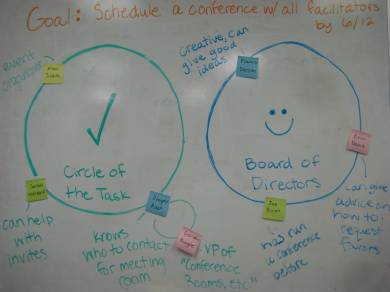Object of Play
When things do not go according to plan, there are two ways we can change our outlook. One is to ignore what is wrong and solely focus on the positives. Although possibly leading to a better attitude when the circumstance surpasses your low expectations, this technique still leaves you with the negative aspects that are causing your cognitive dissonance. Changing your frame of mind is only helpful if the circumstance is impossible to improve, which is not usually the case. That being said, the most beneficial way to truly change the course of our lives is to alter the situation. Wellbeing North Star, created by Kimberly Wiefling, allows you to analyze all angles of your situation in order to reach your desired end state. By comparing what you like and dislike about different aspects of your product, meeting, work day, etc., you can identify where your efforts are needed most to ensure that you achieve your goal.
Number of Players
5 – 8
Duration of Play
1 hour
How to Play
1. Before your meeting, draw a star in the middle of a large poster or whiteboard. In the center of the star, write the topic you are going to focus on (ex. Project X, Conference, Daily schedule). Around the star, write different aspects of the topic you want to discuss with your team (ex. advertisements, graphics, communication, functions).
2. At the beginning of the meeting, distribute plenty of pens and sticky notes (2 different colors) to your participants.
3. For 5 – 10 minutes, have your players to write what they like about the aspects you wrote around the star. Tell them only to write their ideas on one color of sticky note.
4. Ask players to jot down what they dislike about each aspect for the next 5 – 10 minutes, only writing on the other color of sticky note.
5. When everyone is done writing their ideas, have each participant present their notes and post them under the respective aspects on the chart. Cluster all of the “likes” and “dislikes” together to make the results easier to understand.
6. When all of the notes have been posted, collaborate to identify how the ideas can enhance your project. What can be changed? Could you improve your project by simply eliminating any of the “dislikes”? Encourage participants to come up with solutions for the problems they presented.
Strategy
This game can result in major changes, so make sure that everyone is clear on what alterations are going to be made to eliminate any “dislikes.” Consider assigning specific tasks to people to prevent social loafing and to ensure that the changes will indeed be made.
You can play this game with anybody related to your project. Ask customers what they like/dislike about different aspects of your product or service. Or, collaborate with your key partners to determine if your relationship is going according to plan. This activity is adaptable to your needs and can be customized for any audience.
Wellbeing North Star can also be used as a retrospective analysis activity. Rather taking time to correct inferior aspects of your topic before you reach your desired end state, play this exercise after you have finished your project to identify how it can be improved for your iteration.
Play Wellbeing North Star Online
You can instantly play Wellbeing North Star online with as many members as you would like! Clicking on the image above will start an “instant play” game at innovationgames.com; simply email the game link to your team to invite them to play. In the game, the image to the right will be used as the “game board.” You will see three types of icons in the upper left corner.
- Note cards: area of concern
- Happy face: what is working
- Frown face: what is not working
Simply drag the note card icons to the squares and describe the concerns they represent. Then, players can drag the faces to the chart to organize the positive and negative aspects of the concerns.
Players can edit the placement and description of each light bulb, which everyone can view in real time. Use the integrated chat facility and communicate with your players throughout the game to get a better understanding of each move. After the game, the results will be organized in a spread sheet to maximize the benefits of the game.
Key Points
Opinions are valuable when it comes to determining what is and isn’t working. Rather than lowering your expectations and allowing for mediocre results, put in the energy now to enhance your present state. Play Wellbeing North Star to get back on the track that everyone agrees will lead to your goal.










 1. Before your meeting, collect sticky notes or 3×5 notecards. In a white space (a poster, whiteboard, etc.), draw three concentric circles, leaving enough room between each one to place the notes. Each circle represents a different element:
1. Before your meeting, collect sticky notes or 3×5 notecards. In a white space (a poster, whiteboard, etc.), draw three concentric circles, leaving enough room between each one to place the notes. Each circle represents a different element: